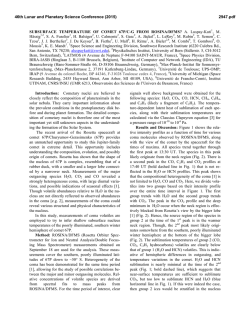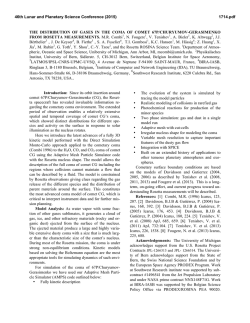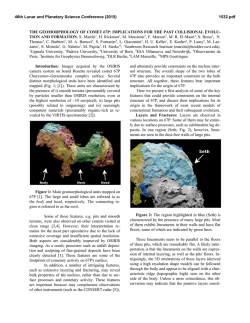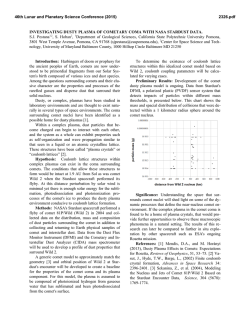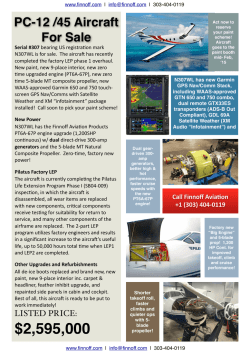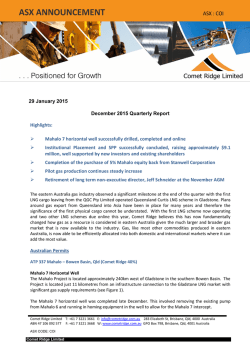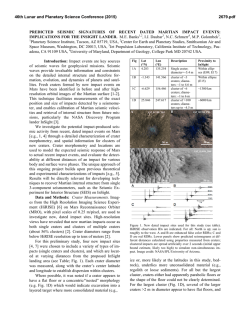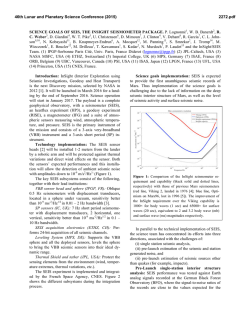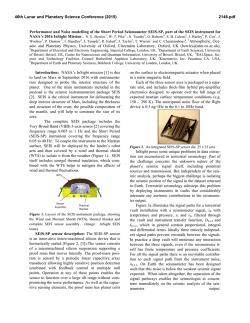
BLOCK MAPPING AND ANALYSIS ON COMETARY NUCLEI
46th Lunar and Planetary Science Conference (2015) 2873.pdf BLOCK MAPPING AND ANALYSIS ON COMETARY NUCLEI: IDENTIFYING AND QUANTIFYING SURFACE CHANGE DUE TO OUTGASSING. J. L. Noviello & E. Asphaug, School of Earth and Space Exploration, Arizona State University. ISTB4, Room 795, 781 E. Terrace Mall, Tempe, AZ 85287- 6004. [email protected]. Introduction: Jupiter family comets make regular approaches to the Sun, and in doing so undergo dramatic surface evolution [1]. Changes can be observed from perihelion to perihelion, and are also observable in real time, as seen on comet 67P/ChuryummovGerasimenko, target of the European Space Agency’s Rosetta mission, where,thermal-driven degradation appears to be creating and reveal structures on the comet [2]. For an orbital mission, feature detection can make it possible to look at images from the same area prior to the feature’s formation and identify surface characteristics that indicated the outburst could occur. These characteristics could potentially take the form of distinctive block mobilization over the surface as a direct result of sub-surface tremors or low-velocity outgassing from inside the comet. Here we focus on using block detection algorithms in order to construct a framework for change-detection imaging of active and potentially active regions on a comet nucleus, both for possible post-processing of Rosetta OSIRIS data [3] and for planning future comet flyby and rendezvous missions with repeated observations of the same terrain. Block Detection. Blocks are excellent data points for small body imaging studies because they are easily mobilized, easily imaged, and very common on small body surfaces. Block mapping literature on small bodies is extensive, and more recent studies have focused on Eros [4] and Itokawa [5-7]. If a mission was able to study its target for an extended period of time, like Rosetta is doing, or in successive perihelia, it may observe not only massive changes such as scarp retreat, but also the distinctive yet more subtle motions of one or more blocks, perhaps indicators of seismic motion associated with outburst phenomena. Unlike asteroids, comets do not need an impact event to trigger mass-wasting [2, 3]; indeed, the sublimation-drive degradation would be sufficient to induce a change on the surface. The extent of the near-surface mobility within the comet (that is, seismic ground motion and/or fluvial entrainment) could in that case be estimated by quantifying the resulting degradation using blocks measurements from before and after images of the feature. The protocol presented here is a potential new method that we are exploring in order to obtain structural information about the seismology of cometary nuclei, with specific application to anticipated data from Rosetta mission to 67P. Knowledge about surface cohesion and seismic attenuation, and velocities of gas entrainment, can inform about the properties of comets and other small bodies, prior to a Comet Nucleus Sample Return mission which is indicated in the NASA Decadal Survey [8] as one of the most important missions yet to be completed. In order for this idea to proceed beyong a concept, more data regarding the mechanical properties of comets must be obtained, by any means possible. Methods: The basic idea can be described as ‘photoseismology’. Using methods already developed for Eros and Itokawa [4-7], we will map discrete blocks as tracers of mass movement, and as subjects of size- and spatial-distribution studies. This will also apply techniques used to study open pit mine collapses and volcanic flank collapses to fully understand the pre-eruption signs of an outgassing event on a comet in an effort to identify future areas of study on 67P. Predicted movement of blocks: Mass movement of material on 67P is expected to occur in the form of regional landslides, localized avalanches, nearby crater collapse, and/or discrete block movements following the outgassing event. Large blocks will be carried by the flow, and the largest discrete blocks will serve as tracers of the flow trajectory. From their before and after positions and timelapsed images, we can construct 3D flow maps tracing the block movement, for use in constraining dynamical models. We propose that these blocks can function as ‘dumb seismometers,’ similar to the way precariously balanced rocks are used by seismologists on Earth as markers of peak seismicity [9]. This analysis can proceed in complex detail, modeling the moments of each block and interpreting the conditions that moved it, or else more simply assuming a small acceleration triggers mass movement [2, 10] or a small velocity triggers ballistic movement. In the ballistic approximation, a seismic impulse with peak particle velocity vp encounters the surface and accelerates materials to distances of order 46th Lunar and Planetary Science Conference (2015) h= vp2/2g, where g is the surface gravity. The ejection of fine particles from the surface will obscure the feature’s initial creation, but large blocks should be easily visible afterwards. Working backwards we can put together a map of peak particle velocities. Block Displacement Measurements: The postoutgassing images will show the effects of the event on the blocks’ displacements. The first step is to measure absolute displacements of identifiable rocks and to determine a correlation between displacement magnitude and linear distance from the center of the outgassing site. The presence of a negative but distinctly non-zero correlation between these two measurements implies that the seismic waves were propagated inside of 67P. If displacement of blocks is observed at the far end of 67P relative to the outgassing, then it is evidence consistent with the idea that 67P is a coherent body. Block Distribution Measurements: The methods of previous block distribution studies [4-7] follow those initially described in [11] and create size frequency distribution (SFD) indices for selected blocks within a defined size range [4-6]. It is unclear how the SFD indices will change after the outgassing; it is possible that large blocks will repopulate the area immediately surrounding the site, while the smaller blocks will escape the comet, with finer regolith mobilized along the surface. Applying this technique to Rosetta’s observations will test a method that would allow quantitative seismology to be done with a simple fly-by mission. Data Collection: The data will be collected using an interactive mapping tool that is able to import images, draw figures (lines, ellipses, polygons, etc.) on the images with respect to a coordinate grid, and overlay multiple images to measure displacement. We suggest using a tool such as the Johns Hopkins University Applied Physics Lab (JHU APL) Small Body Mapping Tool (SBMT), a tool that allows a user to directly map images onto a three-dimensional shape model of an irregularly shaped body [12]. In the case of Rosetta, the source of these images will be OSIRIS narrow and wide angle cameras (OSINAC and OSIWAC, respectively) if and when these images become available. Early images from the Rosetta mission, including its transit and flybys of 2867 Stein and 21 Lutetia, are stored in the Small Bodies Node on the NASA Planetary Data system. Assuming that images of 67P will soon be available in this node, these images will be mapped onto a 3D shape model within SBMT according to their original coordinates to maximize the accuracy of the data return. If possible images from 10 hours 2873.pdf prior to the feature creation and 10 hours after feature creation will be used along with any images or videos taken during the event itself. Ideally the pixel scale will be at most 5 m/pixel, with preference shown to images with smaller pixel scale. Analysis: The average displacements of the large blocks will be used to compute a seismic moment for 67P. On Earth, the seismic moment is linearly proportional to the average displacement. On an asteroid or comet where other variables, such as the shear modulus, may be unknown, the average displacement values could help constrain the value of the seismic moment. In the case of Rosetta, the ancillary knowledge collected could pinpoint a value and provide a reference point to contextualize data collected from other small bodies. To analyze the SFD indices, we will graph the data on a log-log plot, similar to the plot shown in Figure 2. This is the same method used in other studies [4-6, 13]. This will make comparing values among planetary bodies easier, and aid in interpretation and contextualization. Conclusions: Rosetta presents a rare opportunity to directly measure the timeline and formation sequence of features created by sublimation-driven degradation. By studying the before, during, and after images taken of an outgassing region on 67P and applying the methods discussed here, we can potentially constrain the mechanical characteristics of 67P and learn more about its internal structure in general. This method can also direct observations towards potentially active areas on 67P. 67P can serve as a test for applying this method to other comets and small bodies in the future. Data obtained from these studies can be used to inform mission designs in the future and one day lead to a sample return of an active comet nucleus. References: [1] Veverka, J. et al. (2013), Icarus 222, 424-435. [2] Walker, J.D. & Huebner, W.F. (2004), Adv. Space Res. 33, 1564-1569. [3] Sierks, H. (2015), Science, in press. [4] Thomas, P.C., et al. (2001), Nature, 413, 394-396. [5] Barnouin, O.S., et al. (2014) LPS XLV, Abstract #2221. [6] Noviello, J.L., et al. (2014) LPS XLV, Abstract #1587. [7] Mazrouei, S. et al. (2014), Icarus 229, 181-189. [8] National Research Council (2012), 2013-2022 NASA Decadal Survey. [9] Harp, E.L. & Jibson, R.W. (2002), BSSA 92, 3180-3189. [10] Richardson, J.E., et al. (2004), Science 26, 15261529. [11] Crater Analysis Techniques Working Group (1979), Icarus, 37, 467-474. [12] Kahn, E.G. et al. (2011) LPS XLII, Abstract #1618 (sbmt.jhuapl.edu).
© Copyright 2025
